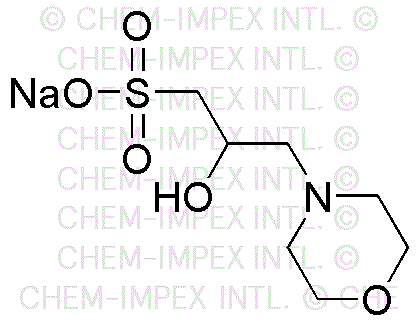3-(N-Morpholino)-2-hydroxypropanesulfonic acid sodium salt is widely utilized in research focused on:
- Biological Buffers: This compound serves as an effective buffering agent in biological and biochemical research, helping to maintain stable pH levels in various experiments, particularly in cell culture and enzyme assays.
- Pharmaceutical Formulations: It is used in the formulation of pharmaceuticals, enhancing the solubility and stability of active ingredients, which is crucial for drug efficacy and patient safety.
- Analytical Chemistry: The compound is employed in analytical methods, such as chromatography, where it aids in the separation and identification of complex mixtures, making it valuable for quality control in laboratories.
- Cosmetic Products: In the cosmetic industry, it acts as a pH stabilizer and conditioning agent, improving the performance and feel of personal care products, which is essential for consumer satisfaction.
- Research and Development: This chemical is often used in the development of new biotechnologies and therapeutic agents, providing researchers with a reliable tool for innovative solutions in various scientific fields.
General Information
Properties
Safety and Regulations
Applications
3-(N-Morpholino)-2-hydroxypropanesulfonic acid sodium salt is widely utilized in research focused on:
- Biological Buffers: This compound serves as an effective buffering agent in biological and biochemical research, helping to maintain stable pH levels in various experiments, particularly in cell culture and enzyme assays.
- Pharmaceutical Formulations: It is used in the formulation of pharmaceuticals, enhancing the solubility and stability of active ingredients, which is crucial for drug efficacy and patient safety.
- Analytical Chemistry: The compound is employed in analytical methods, such as chromatography, where it aids in the separation and identification of complex mixtures, making it valuable for quality control in laboratories.
- Cosmetic Products: In the cosmetic industry, it acts as a pH stabilizer and conditioning agent, improving the performance and feel of personal care products, which is essential for consumer satisfaction.
- Research and Development: This chemical is often used in the development of new biotechnologies and therapeutic agents, providing researchers with a reliable tool for innovative solutions in various scientific fields.
Documents
Safety Data Sheets (SDS)
The SDS provides comprehensive safety information on handling, storage, and disposal of the product.
Product Specification (PS)
The PS provides a comprehensive breakdown of the product’s properties, including chemical composition, physical state, purity, and storage requirements. It also details acceptable quality ranges and the product's intended applications.
Certificates of Analysis (COA)
Search for Certificates of Analysis (COA) by entering the products Lot Number. Lot and Batch Numbers can be found on a product’s label following the words ‘Lot’ or ‘Batch’.
*Catalog Number
*Lot Number
Certificates Of Origin (COO)
This COO confirms the country where the product was manufactured, and also details the materials and components used in it and whether it is derived from natural, synthetic, or other specific sources. This certificate may be required for customs, trade, and regulatory compliance.
*Catalog Number
*Lot Number
Safety Data Sheets (SDS)
The SDS provides comprehensive safety information on handling, storage, and disposal of the product.
DownloadProduct Specification (PS)
The PS provides a comprehensive breakdown of the product’s properties, including chemical composition, physical state, purity, and storage requirements. It also details acceptable quality ranges and the product's intended applications.
DownloadCertificates of Analysis (COA)
Search for Certificates of Analysis (COA) by entering the products Lot Number. Lot and Batch Numbers can be found on a product’s label following the words ‘Lot’ or ‘Batch’.
*Catalog Number
*Lot Number
Certificates Of Origin (COO)
This COO confirms the country where the product was manufactured, and also details the materials and components used in it and whether it is derived from natural, synthetic, or other specific sources. This certificate may be required for customs, trade, and regulatory compliance.


